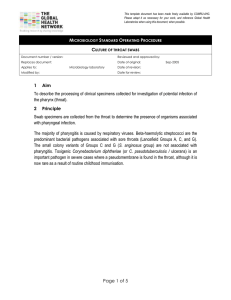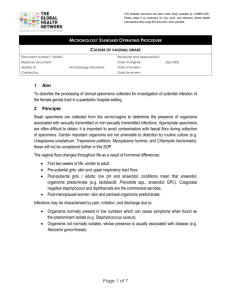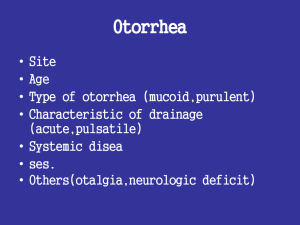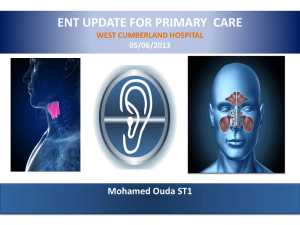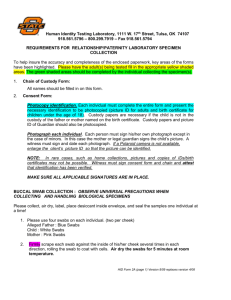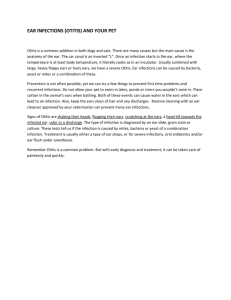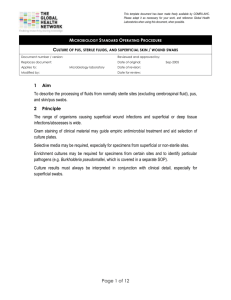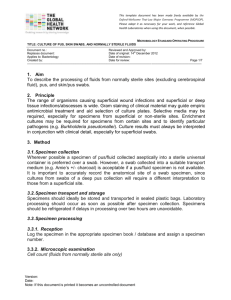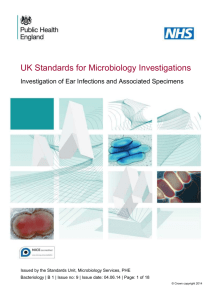Culture of ear swabs - Global Health Laboratories
advertisement
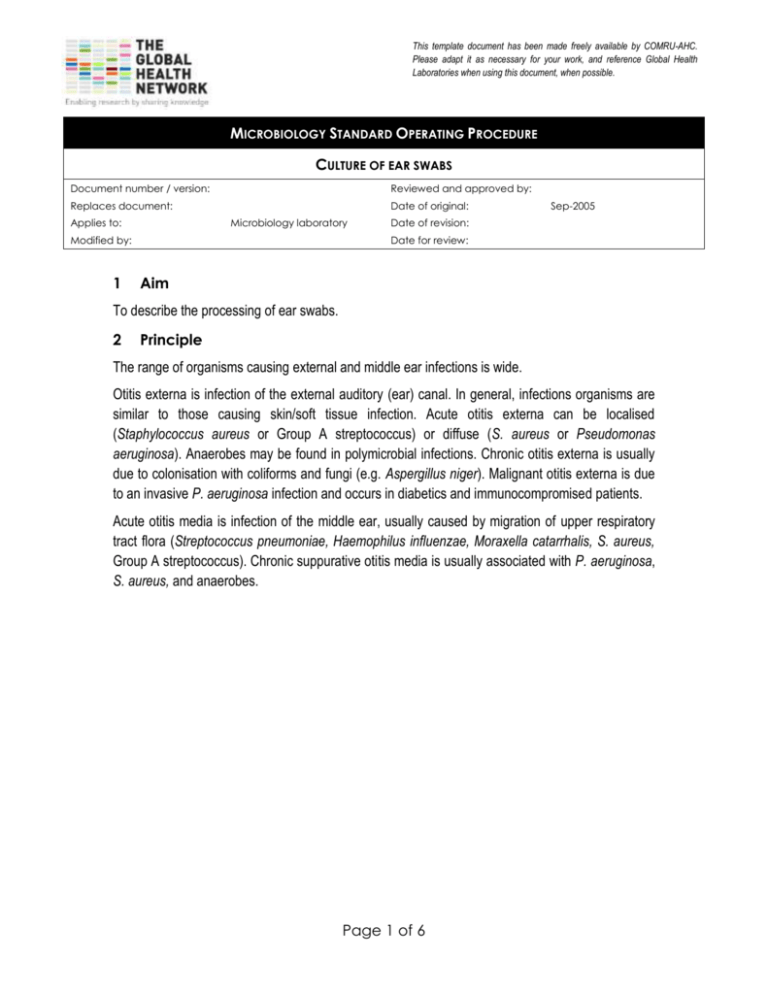
This template document has been made freely available by COMRU-AHC. Please adapt it as necessary for your work, and reference Global Health Laboratories when using this document, when possible. MICROBIOLOGY STANDARD OPERATING PROCEDURE CULTURE OF EAR SWABS Document number / version: Reviewed and approved by: Replaces document: Date of original: Applies to: Microbiology laboratory Modified by: 1 Sep-2005 Date of revision: Date for review: Aim To describe the processing of ear swabs. 2 Principle The range of organisms causing external and middle ear infections is wide. Otitis externa is infection of the external auditory (ear) canal. In general, infections organisms are similar to those causing skin/soft tissue infection. Acute otitis externa can be localised (Staphylococcus aureus or Group A streptococcus) or diffuse (S. aureus or Pseudomonas aeruginosa). Anaerobes may be found in polymicrobial infections. Chronic otitis externa is usually due to colonisation with coliforms and fungi (e.g. Aspergillus niger). Malignant otitis externa is due to an invasive P. aeruginosa infection and occurs in diabetics and immunocompromised patients. Acute otitis media is infection of the middle ear, usually caused by migration of upper respiratory tract flora (Streptococcus pneumoniae, Haemophilus influenzae, Moraxella catarrhalis, S. aureus, Group A streptococcus). Chronic suppurative otitis media is usually associated with P. aeruginosa, S. aureus, and anaerobes. Page 1 of 6 This template document has been made freely available by COMRU-AHC. Please adapt it as necessary for your work, and reference Global Health Laboratories when using this document, when possible. MICROBIOLOGY STANDARD OPERATING PROCEDURE CULTURE OF EAR SWABS Document number / version: 3 Method 3.1 Specimen collection Specimens should be collected using sterile swabs and placed into Amies transport medium (+/charcoal). 3.2 Specimen transport and storage Specimens should ideally be stored and transported in sealed plastic bags. Laboratory processing should occur as soon as possible after specimen collection. Specimens should be refrigerated if delays in processing over two hours are unavoidable. 3.3 Specimen processing 3.3.1 Reception Log the specimen in the appropriate specimen book and assign a specimen number. 3.3.2 Microscopic examination After inoculating the appropriate agar plates prepare a smear of the specimen and Gram stain. 3.3.3 Culture Inoculate and incubate culture media as indicated in Table 1. Page 2 of 6 This template document has been made freely available by COMRU-AHC. Please adapt it as necessary for your work, and reference Global Health Laboratories when using this document, when possible. MICROBIOLOGY STANDARD OPERATING PROCEDURE CULTURE OF EAR SWABS Document number / version: Table 1. Culture media, conditions, and target organisms Standard media Chocolate agar Incubation Temp (°C) Atmosphere Time 35 – 37 5 – 10% CO2 40 - 48h Cultures read Target organism(s) Daily H. influenzae M catarrhalis S. pneumoniae Other organisms may be significant if pure growth CNA-blood agar 35 – 37 Air 40 - 48h Daily β-haemolytic streptococci S. aureus S. pneumoniae MacConkey agar 35 – 37 Air 40 - 48h Daily Enterobacteriaceae Pseudomonads Sabouraud agar 35 – 37 Air 40 - 48h Page 3 of 6 Daily Fungi This template document has been made freely available by COMRU-AHC. Please adapt it as necessary for your work, and reference Global Health Laboratories when using this document, when possible. MICROBIOLOGY STANDARD OPERATING PROCEDURE CULTURE OF EAR SWABS Document number / version: 4 Interpretation Record the semi-quantitative growth of each colony type (i.e. +/- to ++++). 4.1 Minimum level of identification in the laboratory In general significant isolates should be identified as fully as possible (i.e. to species level): potentially significant organisms are summarised in SOP MID-004. Yeasts should be reported to the “yeasts” level. Coliforms should be reported to the “coliforms” level: antimicrobial susceptibility testing is not normally required. Non-P. aeruginosa pseudomonads should be reported to the “pseudomonads” level: antimicrobial susceptibility testing is not normally required. 4.2 Antimicrobial susceptibility testing All significant isolates should have antimicrobial susceptibilities determined according to SOP MIC001. 4.3 Reporting Gram stain results: WBC and organisms detected. Culture: Presence of significant isolates (e.g. S. aureus); no significant growth / mixed growth of doubtful significance may be used; absence of growth. 5 Quality assurance Media and identification tests should be quality controlled according to the relevant SOP. 6 Limitations Prior antimicrobial use may result in negative cultures. 7 References 1. Health Protection Agency, UK SOP B24: Investigation of Ear swabs and associated specimens (Issue 8.4; March 2012). Page 4 of 6 This template document has been made freely available by COMRU-AHC. Please adapt it as necessary for your work, and reference Global Health Laboratories when using this document, when possible. MICROBIOLOGY STANDARD OPERATING PROCEDURE CULTURE OF EAR SWABS Document number / version: 8 Synopsis / Bench aids Page 5 of 6 This template document has been made freely available by COMRU-AHC. Please adapt it as necessary for your work, and reference Global Health Laboratories when using this document, when possible. MICROBIOLOGY STANDARD OPERATING PROCEDURE CULTURE OF EAR SWABS Document number / version: 9 Risk assessment COSHH risk assessment - University of Oxford COSHH Assessment Form Description of procedure Culture of ear swabs Substances used Variable, depending on organism cultured (may include Gram stain reagents; 3% hydrogen peroxide (catalase test); N,N,N',N'-tetramethyl-1,4phenylenediamine (oxidase test); sodium deoxycholate (bile solubility test); bioMerieux API reagents) Quantities of chemicals used Frequency of SOP use Small Daily Hazards identified Could a less hazardous substance be 1. Autoclaved liquid used instead? 2. Potentially infectious material in sample No 3. Potentially pathogenic bacteria 4. Chemical exposure form bacterial identification tests What measures have you taken to control risk? 1. Training in good laboratory practices (GLP) 2. Appropriate PPE (lab coat, gloves, eye protection) 3. Use of biosafety cabinet for reading of plates / follow-up of BSL-3 organisms (e.g. B. pseudomallei) Checks on control measures Observation and supervision by senior staff Is health surveillance required? Training requirements: No GLP Emergency procedures: Waste disposal procedures: 1. Report all incidents to Safety Adviser 1. Sharps discarded into appropriate rigid 2. Use eyewash for splashes containers for incineration 3. Clean up spills using 1% Virkon or 2. Infectious waste discarded into autoclave bags chemical spill kit or 1% Virkon solution prior to autoclaving and subsequent incineration 3. Chemical waste disposed of according to manufacturer’s instructions Page 6 of 6
